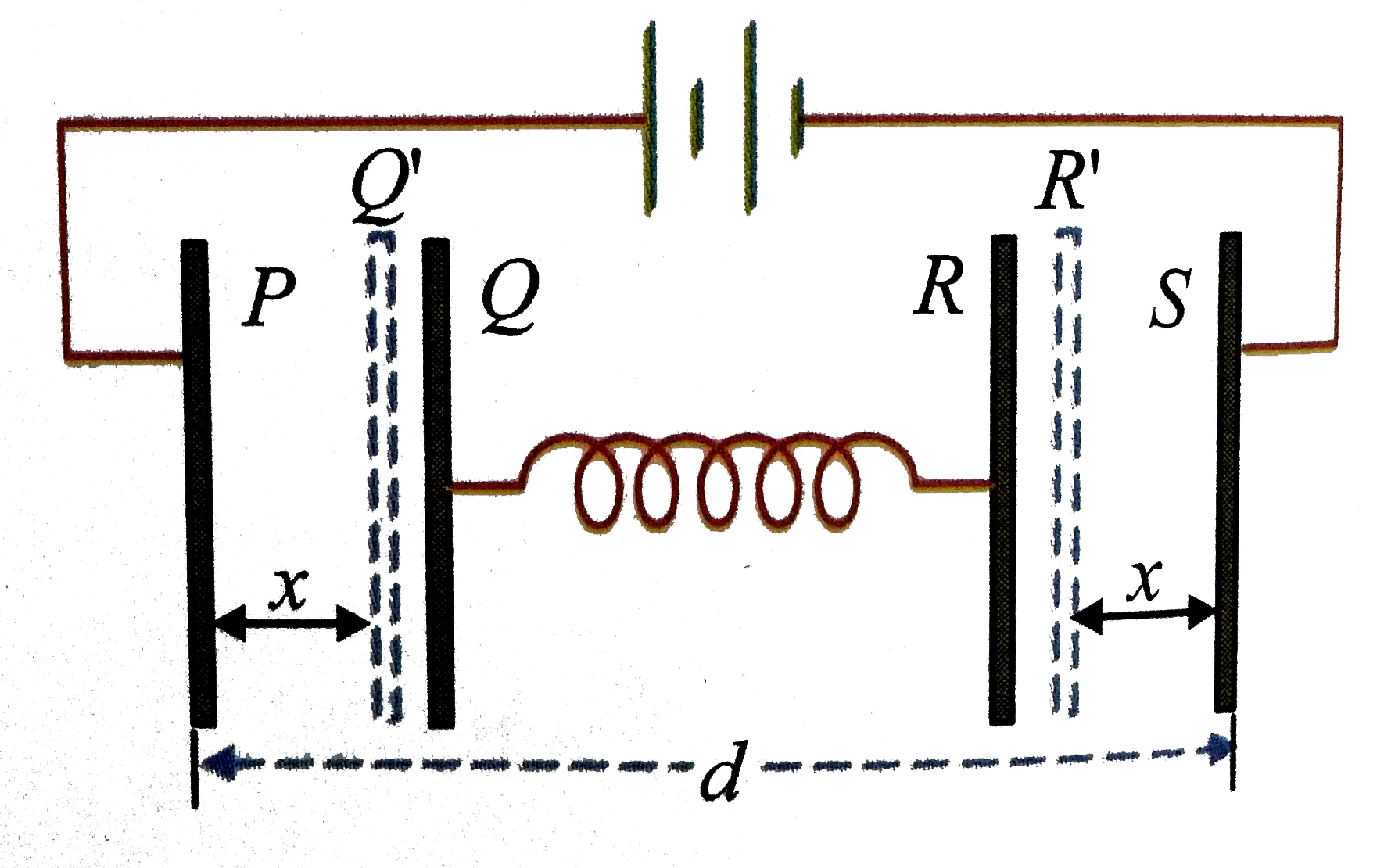Two parallel plate capacitors with area A are connected through a conducting spring of natural length 1 in series as shown. Plates P and save fixed positions at separation d. Now the plates are connected by a battery of emfξ as shown. If the extension in the spring in equilibrium is equal to the separation between the plates, find the spring constant k.
 .
.
k=278Aε0ξ2(d−l)3
k=278Aε0ξ(d−l)3
k=288Aε0ξ(d−l)3
k=278Aε0ξ(d−l)2
The correct Answer is:A
Sol : Let charge on capacitors be q and separation between plates P & Q and R & S be x at any time. Distance between pates P & Q and R & S is same because force acting on them is same.

Capacitance of capacitor PQ,C1=ε0Ax
Capacitance of capacitor RS,=ε0Ax
From KVL, we have 1C1+qC2=ξorq=ε0Aξ2x
Force on plates Q towards P
F1=q22Aε0=ε0A2ξ28Ax2ε0=Aε0ξ28x2
Spring force on plate Q due to extension in spring At equilibrium, separation between plates = extension is spring
Thus x=y(−d−2x−l)⇒x=d−l3 ....(1) ltbrlt At equilibrium, F1=F2 ....(2)
From equation (1) and (2),we have
Aε0ξ28x2=ky=kx⇒x=(Aε0ξ28k)....(3)
From equation (1) and (3),
(d−13)3=Aε0ξ28k⇒k=278Aε0ξ2(d−l)3.
Topper's Solved these Questions
- CAPACITANCEBook:NARAYNAChapter:CAPACITANCEExercise:Level-VI
Explore 28 Videos
- CAPACITANCEBook:NARAYNAChapter:CAPACITANCEExercise:Subjective
Explore 9 Videos
- CAPACITANCEBook:NARAYNAChapter:CAPACITANCEExercise:NCERT Based
Explore 13 Videos
- ATOMS Book:NARAYNAChapter:ATOMS Exercise:EXERCISE -4
Explore 47 Videos
- COMMUNICATION SYSTEMBook:NARAYNAChapter:COMMUNICATION SYSTEMExercise:Level-II(H.W)
Explore 25 Videos
Similar Questions
A paallel plate capacitor with air as a dielectric is arranged horizontally. The lower plate is fixed and the other connected with a perpendicular spring. The area of each plate is A and mass of uppar plate is m. In the steady position, the distance between the plates is d0. When the capacitor is connected with a battery of emf V, a new equilibrium appears, with distance between the plate as d.
(a) find the spring constant k.
(b) what is the maximum voltage for a given k in which an equilibrium is possible?

View SolutionArea of each plate is A. The conducting plates are connected to a battery of emf V volts. Find charges q1 to qt.

View Solution
Knowledge Check
A parallel plate capacitor is connected across a battery. Now, keeping the battery connected, a dielectric slab is inserted between the plates. In the process,
Ano work doneBwork is done by the battery and the stored energy increases.Cwork is done by the external agent, and the stored energy decteases. ltDwork is done by the battery as well as the external agent, but the stored energy done not charge.A parallel plate capacitor of area ‘A’ plate separation ‘d’ is filled with two dielectrics as shown. What is the capacitance of the arrangement ?
 A3Kε0A4dB4Kε0A3dC(K+1)ε0A2dDK(K+3)ε0A2(K+1)d
A3Kε0A4dB4Kε0A3dC(K+1)ε0A2dDK(K+3)ε0A2(K+1)dTwo charged capacitors have their outer plates fixed and inner plates connected by a spring of force constant 'K'. The charge on each capacitor is q. find the extension in the spring at equilibrium
 Aq22Aε0KBq24Aε0KCq2Aε0KDzero
Aq22Aε0KBq24Aε0KCq2Aε0KDzero
A pallel -plate capacitor whith the plate area 100cm2 and the separation between the plate 1.0cm is connected across a battery of emf 24 volts .Find the force of attraction between the plates.
View SolutionTwo charged capacitors have their outer plates fixed and inner plates connected by a spring of force constant k. The magnitude of charge on each capacitor is q and sign of charge on each capacitor is q and sign of charge is shown in figure. Find the extension in the spring at equilibrium.

View SolutionA parallel plate air capacitor is connected to a battery. After charging fully, the battery is disconnected and the plates are pnlled apart to increase their separation. Which of the following statements is correct ?
View SolutionTwo parallel plate capacitors are filled with dielectrics and connected speparately across same potential difference as shown in figure. Their plate area is A and separation between plates is 'd'. Then the ration of energy stored is:
_2019_CBT7_E01_016_Q01.png)
View SolutionIn a parallel-plate capacitor of plate area A, plate separation d and charge Q the force of attraction between the plates is F.
View Solution

